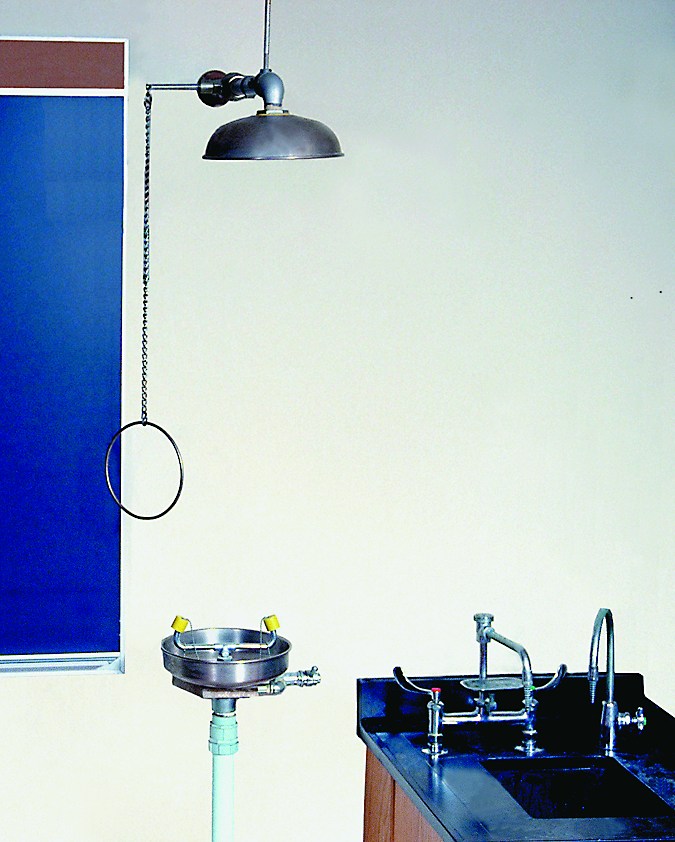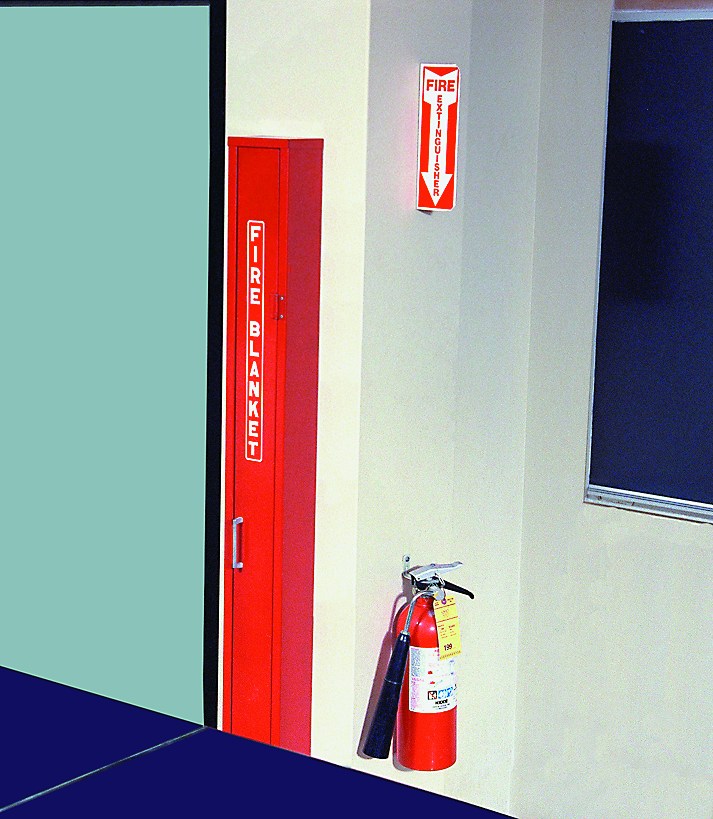Chapter 1.
Overview
Safety in the Laboratory

The Department of Chemistry and Biochemistry
The Ohio State University
Equipment
Safety Shower and Eyewash

The safety shower and eyewash are found in the front of the laboratory. In the event of concentrated acid or other corrosive chemicals being spilled on a large portion of the body, remove contaminated clothing and pull the shower chain. For lesser amounts, there is a pull-out hose on each lab bench for washing off arms and a pull-out hose in the bathrooms for washing off legs. All chemical spills should be washed a minimum of fifteen minutes.
The use of safety goggles is the best way to protect your eyes in the lab. The eyewash should be used to rinse off acid splashed on any part of the face. A minimum of fifteen minutes is required for a thorough washing. Notify your lab instructor immediately.

Fire Blanket and Fire Extinguisher
A tall red metal locker containing the fire blanket is located at the front of the lab. If clothing or hair catches fire, wrap the person in the fire blanket and seek immediate medical assistance.
Many laboratory fires occur in beakers or flasks, and can be extinguished by placing a watch glass over the container. Every lab has a fire extinguisher at the front of the room for larger fires. More serious fires require evacuation of the laboratory room, and notification of the fire department.
Requirements
Students are required to read, understand, and implement the safety precautions indicated in the laboratory manual and laboratory handouts. The precautions are summarized below. The safety forms in your laboratory manual must be signed by all students during their first laboratory period.
- You must wear Department-authorized ANSI code safety glasses in the laboratory. Violation of this policy will result in the loss of 10 points from the experiment of the day. If a second violation occurs, an additional 10 points will be deducted. If a third violation occurs, zero credit will be given for the day’s work. Continued violations will result in dismissal from the course. The wearing of contact lenses is NOT recommended.
- Each student must wear shoes (not sandals) and adequate clothing to reduce the possibility of injury from chemicals or broken glass.
- Familiarize yourself with the location of the fire blanket, fire extinguisher, eyewash and safety shower in the laboratory.
- Promptly report all accidents, no matter how small, to your lab instructor.
- Your work area should be cleaned before you leave lab. After putting your equipment away, wipe down your work area with a wet sponge or towel. This ensures that you and other students who use the space will not be harmed by chemicals left on the desktop. Also clean up spills in the balance room by brushing chemicals into a weighing dish.
- No unauthorized experiments are allowed. No chemicals may be removed from the lab.
Eye Safety
You must guard against the possibility of eye injury or blindness in case chemicals come in contact with your eyes. The Chemistry Department has set policies to minimize the risk of injury to your eyes. In addition, the State of Ohio requires, by law, that industrial-quality, eye-protective devices be worn at all times in the laboratory. Our laboratory instructors are to enforce the use of safety goggles. As soon as possible after entering the laboratory, students shall wear approved eye safety goggles. The very last thing a student should do before leaving lab is remove the goggles. If fogging occurs on humid days, the student should use anti-fog wipes obtained from the storeroom attendant.
The Chemistry Department recommends that contact lenses not be worn in the laboratory. Wearing either the hard or soft type contact lenses in the laboratory poses special problems and may result in eye irritation or injury even if adequate eye protection is worn.
Waste Disposal
I. Chemistry Students and Hazardous Waste
What is hazardous waste?
There are many forms of waste: solid or household waste, radioactive, chemical, infectious, and others such as asbestos. The term “hazardous waste” generally refers to chemical substances which may be ignitable, corrosive, or toxic. Regulations governing hazardous waste Since 1986 liquid hazardous wastes are banned from entering landfills and disposal is governed by strict treatment standards. Comprehensive regulations enforced by the Environmental Protection Agency (EPA) restrict generators of waste (this includes students in chemistry laboratories), transporters of waste, and treatment, storage, and disposal facilities. For major violations the EPA can fine an institution or company up to $70,000 per day per violation. The EPA has also obtained civil and criminal penalties against individuals.
Why do chemistry students need to segregate their waste and why are the TAs so picky about which waste goes where?
Different types of waste have different treatment standards. Organic solvent waste is incinerated, while wastes containing heavy metals are treated and solidified before being buried in a secure landfill. Generators of hazardous wastes, industrial plants and chemistry students alike, need to follow not only the strict EPA regulations but also those rules set forth by individual transporters and treatment, storage, and disposal facilities. Students and TAs are required to segregate and keep accurate records of the different wastes they generate as part of the laboratory experiments. When waste is taken to an incinerator, regular tests are performed to ensure that the composition and amounts of the waste match the list of chemicals on the waste container. The most common violations include the presence of heavy metals (lead, chromium, cadmium, and others) and an excessive pH (above 9 or below 5) due to improper disposal of acids and bases into organic liquid waste cans. Too many violations may result in termination of the waste disposal service.
What can a lab student do to help?
The TAs have a tough job. Not only do they have to instruct students but they are also responsible for the safety of the students and the accuracy of the waste disposal. This is a formidable task and requires the full cooperation of the lab students. A lab student needs to understand his or her responsibility as a generator of hazardous waste. This includes knowing exactly what waste is being produced, and where it goes for disposal. Although these regulations can be burdensome at times, they are necessary in order to effectively prevent the mismanagement of hazardous waste. In this era of heightened environmentalism, we can all do something, however small, to prevent the tragedies of the past.
II. Specific Guidelines for Waste Disposal
All general chemistry courses require you to perform laboratory experiments which may involve the production of hazardous chemical waste. Universities are now recognized as major producers of chemical waste and therefore responsible for its disposal. To properly dispose of chemical waste, it is essential to know the identity of all hazardous material.
For every experiment, you will receive instructions from the lab manual, the videotape, and your teaching assistant on proper disposal. Waste is disposed by these methods:
a. Metal salts: white beaker labeled Inorganic
Solutions and/or solids containing heavy metals—Ag, Ba, Co, Cr, Mn, Mo, Ni, Pb, Sb, Sn, and all sulfides. All solutions must first be adjusted to pH 7 by the addition of 6 M NaOH.
b. Organic solutions: red beaker labeled Organic
Organic solutions which do NOT contain any of the above metals. All solutions must first be adjusted to pH 7 by the addition of sodium bicarbonate.
c. Dry organic solids: plastic jar labeled Organic Solids
d. Some synthesized compounds are collected in plastic packets and subsequently disposed.
e. Pure acids and bases and aqueous solutions devoid of heavy metals and organics should be washed down the sink drain with a large amount of water.
f. Empty unknown vials and rinse with water, then dispose as clean glass. If glassware cannot be cleaned and reused, dispose appropriately in the broken or uncleanable glass waste.
The Chemical Waste Disposal Form shown will be provided by your TA for each type of waste generated. It is your responsibility to sign the sheet and record the approximate amount of waste you are disposing. Waste is always collected in beakers before it is put into a container by the TA.
Video

Credits
